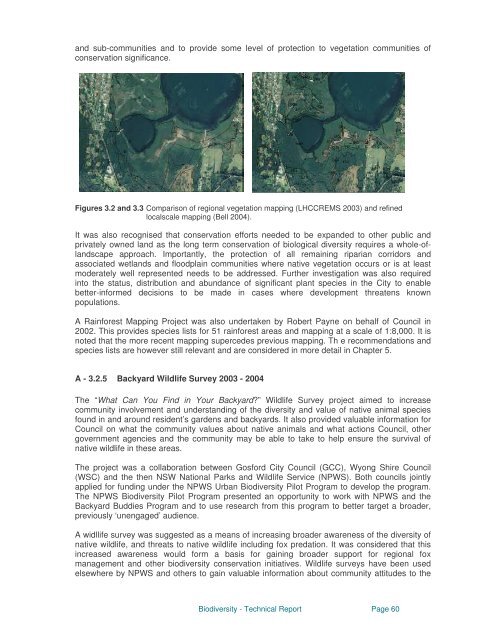Biodiversity Strategy - Gosford City Council - NSW Government
Biodiversity Strategy - Gosford City Council - NSW Government
Biodiversity Strategy - Gosford City Council - NSW Government
You also want an ePaper? Increase the reach of your titles
YUMPU automatically turns print PDFs into web optimized ePapers that Google loves.
and sub-communities and to provide some level of protection to vegetation communities of<br />
conservation significance.<br />
Figures 3.2 and 3.3 Comparison of regional vegetation mapping (LHCCREMS 2003) and refined<br />
localscale mapping (Bell 2004).<br />
It was also recognised that conservation efforts needed to be expanded to other public and<br />
privately owned land as the long term conservation of biological diversity requires a whole-oflandscape<br />
approach. Importantly, the protection of all remaining riparian corridors and<br />
associated wetlands and floodplain communities where native vegetation occurs or is at least<br />
moderately well represented needs to be addressed. Further investigation was also required<br />
into the status, distribution and abundance of significant plant species in the <strong>City</strong> to enable<br />
better-informed decisions to be made in cases where development threatens known<br />
populations.<br />
A Rainforest Mapping Project was also undertaken by Robert Payne on behalf of <strong>Council</strong> in<br />
2002. This provides species lists for 51 rainforest areas and mapping at a scale of 1:8,000. It is<br />
noted that the more recent mapping supercedes previous mapping. Th e recommendations and<br />
species lists are however still relevant and are considered in more detail in Chapter 5.<br />
s<br />
A - 3.2.5 Backyard Wildlife Survey 2003 - 2004<br />
The “What Can You Find in Your Backyard?” Wildlife Survey project aimed to increase<br />
community involvement and understanding of the diversity and value of native animal species<br />
found in and around resident’s gardens and backyards. It also provided valuable information for<br />
<strong>Council</strong> on what the community values about native animals and what actions <strong>Council</strong>, other<br />
government agencies and the community may be able to take to help ensure the survival of<br />
native wildlife in these areas.<br />
The project was a collaboration between <strong>Gosford</strong> <strong>City</strong> <strong>Council</strong> (GCC), Wyong Shire <strong>Council</strong><br />
(WSC) and the then <strong>NSW</strong> National Parks and Wildlife Service (NPWS). Both councils jointly<br />
applied for funding under the NPWS Urban <strong>Biodiversity</strong> Pilot Program to develop the program.<br />
The NPWS <strong>Biodiversity</strong> Pilot Program presented an opportunity to work with NPWS and the<br />
Backyard Buddies Program and to use research from this program to better target a broader,<br />
previously ‘unengaged’ audience.<br />
A widllife survey was suggested as a means of increasing broader awareness of the diversity of<br />
native wildlife, and threats to native wildlife including fox predation. It was considered that this<br />
increased awareness would form a basis for gaining broader support for regional fox<br />
management and other biodiversity conservation initiatives. Wildlife surveys have been used<br />
elsewhere by NPWS and others to gain valuable information about community attitudes to the<br />
<strong>Biodiversity</strong> - Technical Report Page 60
















